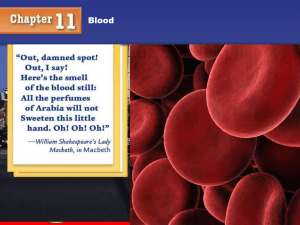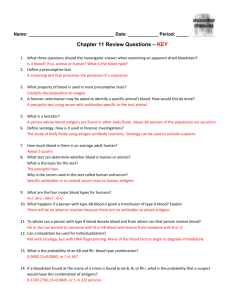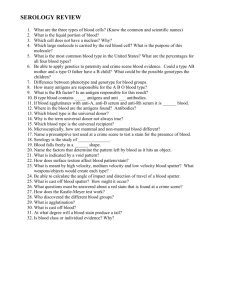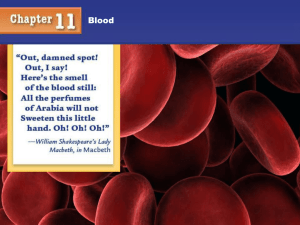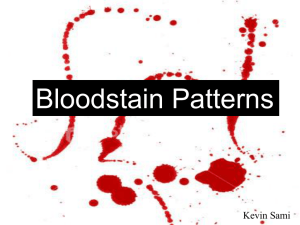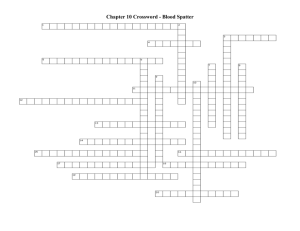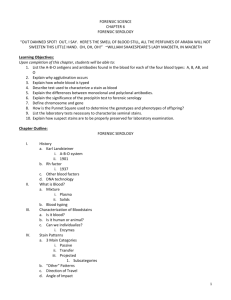FORENSIC SCIENCE Serology
advertisement
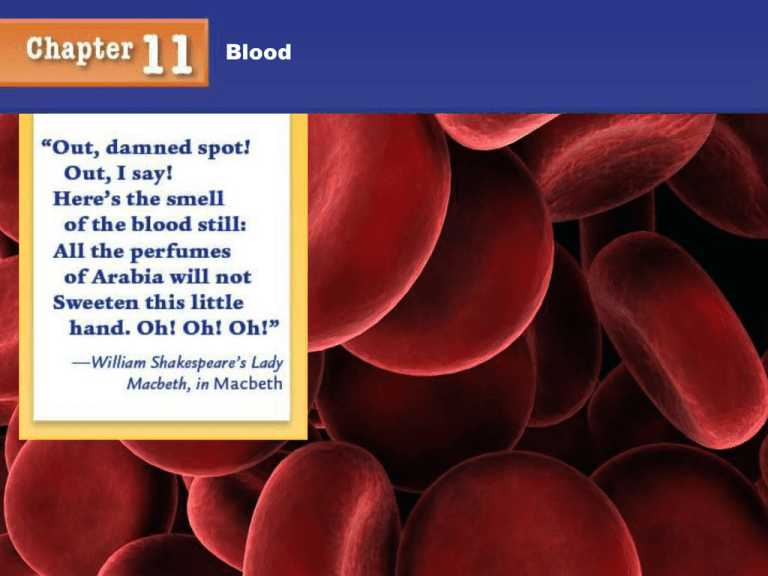
Blood Blood Objectives You will understand: That an antibody and an antigen of different types will agglutinate, or clump, when mixed together. That the significance of the evidence depends on a characteristic’s relative occurrence in the population. 2 Blood Objectives, continued You will be able to: Determine whether a stain is blood. Determine whether a bloodstain is human or animal blood. Determine the blood type of a simulated bloodstain using the ABO/Rh system. Explore bloodstain patterns as a function of velocity, direction, and height of fall. Use technology and mathematics to improve investigations and communications. 3 Blood Serology Serology is the examination and analysis of body fluids. A forensic serologist may analyze a variety of body fluids including saliva, semen, urine, and blood. From 1950 to the late 1980s, forensic serology was a most important part of lab procedures. With the development of DNA techniques, more time, money, and significance were placed on developing DNA labs. However, with limited funds and the time required for DNA testing, most labs still use many of the basic serology testing procedures. 4 Blood Blood Characteristics Plasma is the fluid portion of the blood (55 percent). Cells (45 percent) Erythrocytes are red blood cells. They are responsible for oxygen distribution. Leukocytes are the white blood cells; they are responsible for “cleaning” the system of foreign invaders. Thrombocytes or platelets are responsible for blood clotting. Serum is the liquid that separates from the blood when a clot is formed. 5 Blood Historical Perspective of Blood Typing Around 1900, Karl Landsteiner discovered that there are four different types of human blood based on the presence or absence of specific antigens found on the surface of the red blood cells. In 1940, Landsteiner and Weiner reported the discovery of the Rh factor by studying the blood of the Rhesus monkey. 85 percent of Caucasians, 94 percent of Black Americans, and 99 percent of all Asians are Rh positive. 6 Blood Blood Terminology ABO blood groups—based on having A, B, both, or no antigens on red blood cells. Around 1900, Karl Landsteiner discovered that there are four different types of human blood based on the presence or absence of specific antigens found on the surface of the red blood cells. Rh factor—may be present on red blood cells; positive if present and negative if not. In 1940, Landsteiner and Weiner reported the discovery of the Rh factor by studying the blood of the Rhesus monkey. 85 percent of Caucasians, 94 percent of Black Americans, and 99 percent of all Asians are Rh positive. 7 Blood Antigen—a substance that can stimulate the body to make antibodies. Certain antigens (proteins) found in the plasma of the red blood cell’s membrane account for blood type. (0-4:17 only of the 10:45 min video. Antibody—a substance that reacts with an antigen Agglutination—clumping of red blood cells; will result if blood types with different antigens are mixed. ~ 2:00 min http://nobelprize.org/educational/medicine/landsteiner/readmore.html 8 Blood Unknown Stain at a Scene Questions to be answered: Is it blood? Is it human blood? Whose is it? Determine blood type, alcohol content, drugs present Determine the method(s) in which blood may have been deposited 9 Blood Presumptive Tests for Blood Determination Kastle-Meyer color test—a mixture of phenolphthalein and hydrogen peroxide; the hemoglobin will cause the formation of a deep pink color if blood is present Hematest tablet—reacts with the heme group in blood, causing a bluegreen color Luminol test—reaction with blood to produce light 10 Blood Human versus Animal Blood Microscopic observation-Animals have larger nucleic red blood cells Precipitin test—blood is injected into a rabbit; antibodies are formed; the rabbit’s blood is extracted as an antiserum; the antiserum is placed on sample blood. The sample will react with human proteins if human blood is present. This test is very sensitive and requires only a small amount of blood. 11 Blood Animal Blood Larger nucleic red blood cells Frog blood Smaller nucleic red blood cells Human Blood 12 Blood Microscopic Views Fish Blood Bird Blood Horse Blood Frog Blood Cat Blood Dog Blood Human Blood 13 Snake Blood Blood Human Blood Red blood cells are most numerous; 5 to 6 million per mm3 White blood cells are larger and less numerous; 5,000 to 10,000 per mm3 Platelets are tiny, cellular fragments; 350,000 to 500,000 per mm3 14 Blood Blood Typing Blood type A has antigen A on the surface of the cell and will agglutinate with blood type B. Blood type B has antigen B on the surface of the cell and will agglutinate with blood type A. Blood type AB has antigens A and B on the surface of the cells and will not agglutinate with either type A or type B blood. Blood type O has neither antigen A nor B and will not agglutinate. Secretors Eighty percent of the population are secretors. Their blood-type antigens are found in high concentration in their body fluids such as saliva, semen, vaginal secretions, and gastric juices. 15 Blood Blood Groups Type Antigen Antibody Can Give Can Get Blood To Blood From A A B A, AB O, A B B A B, AB O, B AB A and B Neither A nor B AB A, B, O, AB O Neither A nor B A and B A, B, O, AB O 16 Blood Population Distribution of Blood Types in the U.S. Type Percent O 45 A 40 B 11 AB 4 17 Blood How common is your blood type? 18 Blood Blood Transfusions A blood transfusion is a procedure in which blood is given to a patient through an intravenous (IV) line in one of the blood vessels. Blood transfusions are done to replace blood lost during surgery or a serious injury. A transfusion also may be done if a person’s body can't make blood properly because of an illness. Who can give you blood? People with TYPE O blood are called Universal Donors, because they can give blood to any blood type. Universal Donor People with TYPE AB blood are called Universal Recipients, because they can receive any blood type. Rh + Can receive + or Rh - Can only receive - Universal Recipient 19 Blood Blood Products from Blood Banks, Donations and Drives 20 Blood Blood Evidence Class evidence for blood includes blood type. If you can determine the DNA, you will have individual evidence. 21 Blood Blood Pattern Reconstruction Scene Pattern Reconstruction Lab Results Reconstruction 1. Stain condition 1. Genetic marker typing 2. Pattern 2. Age determination 3. Distribution 3. Source determination 4. Location 4. Race determination 5. Directionality 5. Sex determination —From Cracking Cases by Dr. Henry C. Lee and Thomas W. O’Neil 22 Blood Blood Spatter Evidence A field of forensic investigation that deals with the physical properties of blood and the patterns produced under different conditions as a result of various forces being applied to the blood. Blood, as a fluid, follows the laws of physics. Bloodstain patterns are considered circumstantial evidence in a courtroom. Experts can argue many points, including direction of travel, height of the perpetrator, position of the victim, left/right hand, whether the body was moved, etc. 23 Blood People of Historical Significance Paul Kirk (1902–1970) was a professor of criminalistics and biochemistry at the University of California at Berkeley. He actively assisted law enforcement organizations from 1935 to 1967. His book Crime Investigation contained a chapter in which he discussed the application of bloodstain pattern analysis to criminal investigations. Dr. Kirk analyzed the bloodstain pattern photos from the Sam Sheppard case and was instrumental in Sheppard’s release after his second trial. Find out more about the case at truTV’s Crime Library. 24 Blood Blood Droplet Characteristics A blood droplet remains spherical in space until it collides with a surface. Once a blood droplet impacts a surface, a bloodstain is formed. Droplets falling from the same height, hitting the same surface at the same angle, will produce stains with the same basic shape. How will the shape change as the height is increased or decreased? 25 Blood Blood Droplet Volume A droplet contains approximately 0.05 cc of fluid. Is not the same for all blood droplets, but is generally from 0.03 cc to 0.15 cc Is directly dependent upon the surface or orifice from which it originates The impact area is called the target. 26 Blood Conditions Affecting Shape of Blood Droplet Size of the droplet Angle of impact Velocity at which the blood droplet left its origin Height Texture of the target surface • On clean glass or plastic—droplet will have smooth outside edges • On a rough surface—will produce scalloping on the edges 27 Blood Conditions Affecting Shape of Blood Droplet Size of the droplet Angle of impact Velocity at which the blood droplet left its origin Height Texture of the target surface • On clean glass or plastic—droplet will have smooth outside edges • On a rough surface—will produce scalloping on the edges 28 Blood Angle of Impact 29 Blood Questions Answered by Blood Spatter Interpretation The distance between the target surface and the origin of the blood The point(s) of origin of the blood Movement and direction of a person or an object The number of blows, shots, etc., causing the bloodshed and/or the dispersal of blood Type and direction of impact that produced the bloodshed The position of the victim and/or object during bloodshed Movement of the victim and/or object after bloodshed 30 Blood Bloodstain Patterns Considerations The harder and less porous the surface, the less the blood drop will break apart. The softer and more porous the surface, the more the blood drop will break apart. The pointed end of the bloodstain faces the direction of travel. 31 Blood Bloodstain Terminology Angle of impact—angle at which blood strikes a target surface Bloodstain transfer—when a bloody object comes into contact with a surface and leaves a patterned blood image on the surface Backspatter—blood that is directed back toward the source of energy Cast-off—blood that is thrown from an object in motion 32 Blood Bloodstain Terminology, continued Contact stain—bloodstains caused by contact between a wet bloodbearing surface and a second surface that may or may not have blood on it • Transfer—an image is recognizable and may be identifiable with a particular object • Swipe—wet blood is transferred to a surface that did not have blood on it • Wipe—a non-blood-bearing object moves through a wet bloodstain, altering the appearance of the original stain 33 Blood Bloodstain Terminology, continued Directionality—relates to the direction a drop of blood travels in space from its point of origin Terminal velocity—the greatest speed to which a free-falling drop of blood can accelerate in air. It is dependent upon the acceleration of gravity and the friction of the air against the blood—approximately 25.1 feet/second. • High velocity—greater than 25 feet per second, usually 100 feet per second; gives a fine mist appearance. • Medium velocity—5 to 25 feet per second. • Low velocity—5 feet per second or less High, Medium, and Low described in detail on the next three slides. 34 Blood High velocity—greater than 25 feet per second, usually 100 feet per second; gives a fine mist appearance. result of gunshot wounds explosions. The pattern appears as a spray of minute drops. Bullet wounds leave both front and back sprays. Back sprays are usually smaller than front sprays. 35 Blood Medium velocity—5 to 25 feet per second. the result of being hit with blunt objects, stab wounds, or being dealt particularly vicious blows with fists. In cases where the victim has been beaten or stabbed, the arteries can be damaged. If the wounds are close enough to the skin, the victim will bleed faster and blood may spurt out of the wound as the heart beats. The outcome is a large amount of blood and a distinctive pattern called arterial spurting pattern. The diameter of the droplets is 36 Blood Low velocity—5 feet per second or less. low velocity spatter is typically caused by dripping blood. This type of spatter is usually the result of a sustained injury rather than by the impact that caused the wound. Blood pooling around a body and transfers are also considered low velocity spatters. Low velocity spatter can also be caused by punches or kicks 37 Blood Blood Spatter Analysis There are also multiple ways to analyze blood spatter. One method is to use a trigonometric calculation. The measurements of the blood stain will become the sides of a right triangle. The length is the hypotenuse and the width is the opposite angle. The analyst has to measure the spatter’s length and width and then insert it into the equation on the next slide. 38 Blood Bloodstain Patterns The shape of a blood drop: Round—if it falls straight down at a 90-degree angle Elliptical—blood droplets elongate as the angle decreases from 90 to 0 degrees; the angle can be determined by the following formula: Impact angle, i = arc sin ( drop width, w ) ( drop length, l ) The arc sin can be calculated with your calculator or found by using a table such as Table 11.6 on page 327 39 Blood Impact The more acute the angle of impact, the more elongated the stain. 90-degree angles are perfectly round drops; 80-degree angles take on a more elliptical shape. At about 30 degrees the stain will begin to produce a tail. The more acute the angle, the easier it is to determine the direction of travel. 40 Blood Bloodstain Patterns The harder and less porous the surface, the less the blood drop will break apart. The softer and more porous the surface, the more the blood drop will break apart. The pointed end of the bloodstain faces the direction of travel. 41 Blood Area of Intersection and Convergence The location of the blood source can be determined by drawing lines from the various blood droplets to the point where they intersect. The area of convergence is the point of origin—the spot where the “blow” occurred. It may be established at the scene by measurement of angles with the use of strings. 42 Blood Area of Intersection and Convergence Another method of finding the area of convergence is called stringing. The analyst documents the location of the spatters on a coordinate system and the sets up a level line to show the spatters in relation to the floor and ceiling. Using elastic string, they draw lines from each spatter through the level line. Then using a protractor on the level line, the analyst determines the angle of flight to try and find the area of convergence. 43 Blood 44 Blood Blood Evidence Class evidence for blood includes blood type. If you can determine the DNA, you will have individual evidence. Bloodstain patterns are considered circumstantial evidence in a courtroom. Experts can argue many points, including direction of travel, height of the perpetrator, position of the victim, left/right hand, whether the body was moved, etc. 45 Blood Secretors Eighty percent of the population are secretors. Their bloodtype antigens are found in high concentration in their body fluids such as saliva, semen, vaginal secretions, and gastric juices. 46 Blood People in the News Herbert L. MacDonell is considered by many to be the father of modern bloodstain pattern analysis. He is the director of the Lab of Forensic Science and founder of the Bloodstain Evidence Institute (1973) in Corning, NY. His book Bloodstain Pattern Interpretation helped to jump-start this discipline. He has consulted on criminal cases in all 50 states, in addition to testifying in the O. J. Simpson trial and in the assassination cases of Sen. Robert F. Kennedy and Dr. Martin Luther King, Jr. 47 Blood More about Serology For additional information about blood evidence, and famous crimes that involve serology, check out truTV’s Crime Library at: www.crimelibrary.com/criminal_mind/forensics/serology/1.html 48
